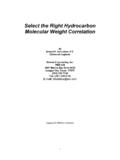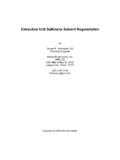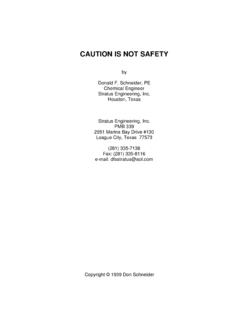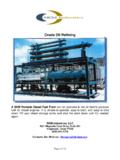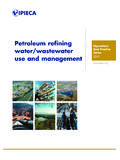Transcription of PRACTICAL PROCESS HYDRAULICS CONSIDERATIONS
1 PRACTICAL PROCESS HYDRAULICS CONSIDERATIONS by Donald F. Schneider, PE Chemical Engineer Stratus Engineering, Inc. Houston, Texas M. Chris Hoover Mechanical Engineer Koch Industries Wichita, Kansas Stratus Engineering, Inc. PMB 339 2951 Marina Bay Drive #130 League City, Texas 77573 (281) 335-7138 Fax: (281) 335-8116 e-mail: Copyright 1999 Stratus Engineering, Inc. STRATUS ENGINEERING 1 Introduction A fluid moving through pipe or equipment is a well understood phenomena. There are some fluid flow areas that would benefit from improved understanding. Two-phase flow, flow through packed beds, and flow associated with phase changes are examples. But for the most part existing analytical methods predict behavior reasonably well. However, having a firmly rooted understand of what the fluid will do does not explain what affect this will have.
2 Where hydraulic calculations meet PROCESS requirements can be thought of as PROCESS HYDRAULICS . Application of the well defined fluid flow equations to achieve well defined PROCESS goals may follow a dimly lit path. Real-world illustrations highlight several ways you can get off-course. Unusual Conditions Often an equipment design basis does not account for abnormal conditions. Startup, shutdown, upset operation, feed changes, and maintenance requirements are cases where a compressor or pump may need to produce beyond its normal performance envelope. Recycle and makeup hydrogen compressors for hydroprocessing reactor systems occasionally must operate within a varying range of hydrogen purity. Often an entirely different gas such as air or nitrogen must be accommodated for catalyst regeneration. When a compressor's hydrogen supply purity increases at a constant compression ratio the compressor discharge temperature increases due to a rise in the heat capacity ratio (k = Cp/Cv) of the gas being compressed.
3 A reduction in hydrogen purity generally increases fluid horsepower requirements through an increase in molecular weight. A Gulf-Coast refinery recently changed a hydrodesulfurizer hydrogen supply source from 70% purity reformer hydrogen, to imported 99% purity hydrogen. Due to the increase in heat capacity ratio, the reciprocating hydrogen makeup compressors experienced a significant rise in discharge temperature. The discharge temperature increased from 190 F to 290 F at the same pressure ratio. This resulted in immediate compressor valve reliability problems. Like compressors, pumps can also be impacted by fluid property changes. Recently, a gas fractionator plant was starting up after a turnaround during which substantial debottlenecking construction had occurred. During the startup, the Product Ethane pumps, which deliver high purity Ethane to a pipeline, continually tripped off-line.
4 Mechanically and electrically the pumps appeared in good shape. Investigation of the PROCESS revealed two problems: at startup the Ethane purity is low resulting in a heavier than normal hydrocarbon feeding the pumps, and unsuccessful startup STRATUS ENGINEERING 2 preparation had left large amounts of Water in the unit. Among the problems caused was erratic Product Ethane pump performance. Figure 1 depicts the Product Ethane pump performance curve. Operating points are shown for Ethane and Water. The pump operates at a relatively constant P taking suction from a distillation column reflux drum and delivering Ethane to a pipeline. Equation 1 defines the relationship between pump pressure increase and the pump's differential Feet of Head which is plotted versus pump flow rate in the pump performance curve of Figure 1.
5 NecessaryPumpHeadftxPpsiFluidSpecificGra vity().()=231 (1) When the pumped fluid changes from Ethane to Water, the fluid Specific Gravity ( ) rises from to Equation 1 shows that to increase Water's pressure the same amount as Ethane's it takes only 35% as much Head. But, the pump must operate on its curve. Lowered pump head is produced by increased flow rates. This is illustrated by the operating points in Figure 1. The Water operating point is far out on the curve compared to Ethane operation. Equation 2 describes the effect this has on the amount of energy the pump needs to do its job. HydraulicHorsepowerFlowgpmxPpsi=()() 1714 (2) hydraulic Horsepower is the energy imparted to the fluid by the pump to generate a pressure rise with a concomitant flow rate. When the of the pumped fluid increases substantially at constant P, as in our case, the pump flow jumps according to its performance curve.
6 Required Horsepower also jumps proportionally to the flow increase as shown by Equation 2. Because moving out to the end of the pump curve typically also moves away from the Best Efficiency Point, pump efficiency diminishes causing a magnified Horsepower demand on the device driving the pump - a motor in our case. These factors can combine to require more Horsepower than the motor driving the pump is rated for. The motor over-amps and trips. One way to work through these problems is to pinch down pump outlet valves. This raises the required pump head and lowers the flow rate thereby reducing the necessary pump driver Horsepower. Operation with heavier than normal hydrocarbon at startup probably can be economically accounted for in the pump design. For this pump, water operation would be costly to accommodate. STRATUS ENGINEERING 3 Volumetric FlowFeet of HeadEthaneWater Figure 1.
7 Product Ethane Pump Curve. STRATUS ENGINEERING 4 Another area Water can cause similar problems is in distillation column reflux operation. In systems where it is imicible and more dense than the other phase, water is often separated from hydrocarbon in a column's overhead accumulator by gravity difference. Water settles into a boot or behind a weir. Figure 2 provides an illustration. However, Water may be fed to the reflux pumps for several reasons. A PROCESS upset, accumulator fouling, or accumulator Water level control malfunction may diminish the accumulator Water separating efficiency. Under some circumstances, water may purposely be sent to the tower as reflux. This may be done to Water-wash the column to clean trays, or during a shutdown to clean the vessel. Assuming column pressure and frictional losses are similar, reflux pumping of Water instead of hydrocarbon requires an increased pump pressure rise.
8 This is due to the higher static head necessary to push Water to the top of the tower. In this case, the pump continues to produce the same Feet of Head at the same flow rate. The distance, or Feet of Head, to the column top has not changed. However, the pump P rises in response to the Water's increased density. Equation 2 shows that the required Horsepower increases proportionally to the pump P gain. The reflux pumps could demand more from their drivers than they are rated to deliver. STRATUS ENGINEERING 5 AccumulatorWaterRefluxColumn OverheadCondenserH Figure 2 - Reflux HYDRAULICS . STRATUS ENGINEERING 6 Two Phase Fluids PROCESS streams at or near their bubble point can pose special hydraulic problems. The static head change from a piping rise may be a sufficient pressure reduction to result in vaporization of a bubble point fluid.
9 Typically the amount of vapor formed is small as the cooling associated with vaporization retards the behavior. However, even a little vapor can sharply increase frictional pressure losses as the now two-phase fluid travels through a pipe. Higher frictional loss will raise the vapor fraction feeding additional frictional loss. Distillation columns utilizing heat pumps for combined condensing and reboiling are one place where the complications of bubble point fluids might arise. Figure 3 illustrates a Heat Pump layout. A Heat Pump condenses a column's overhead vapor by using it to reboil the column from which it came. This is accomplished through compression of the overhead vapor. Where it is feasible, a Heat Pump requires the energy for compressor operation and a small amount of trim heating/cooling utility, where a conventional column needs full overhead cooling and bottoms heating utilities.
10 There are many economic trade-offs between capital and utilities costs that affect the selection of a Heat Pump over a conventional design. But where it is PRACTICAL , it can be very profitable. Recently a Deisobutanizer (DIB) column operating with a Heat Pump began to have compressor trips during the summer. Compressor flow would begin to taper off, the low-flow kickback would open (the kickback had no cooler), and shortly thereafter the compressor would trip on high discharge temperature. An investigation revealed several contributing elements. One substantial factor was due to bubble point and equilibrium liquids. The Figure 3 illustration captures the important points of the system under review. During the summer, upstream cooling constraints caused DIB operation changes which resulted in the liquid at Point A in Figure 3 approaching its bubble point.
